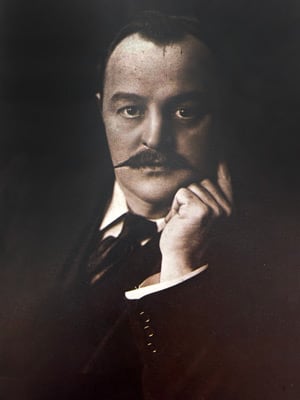
By 1910, at just 35 years old, Francis Sangorski had already established himself as a highly-skilled bookbinder alongside his business partner George Sutcliffe. Through their meticulous craftsmanship, they became renowned for their elaborate leather bindings adorned with semi-precious jewel inlays and intricate gold tooling on sought-after editions of classic works; bindings which could take months or even years to complete. Now they planned their most ambitious creation.
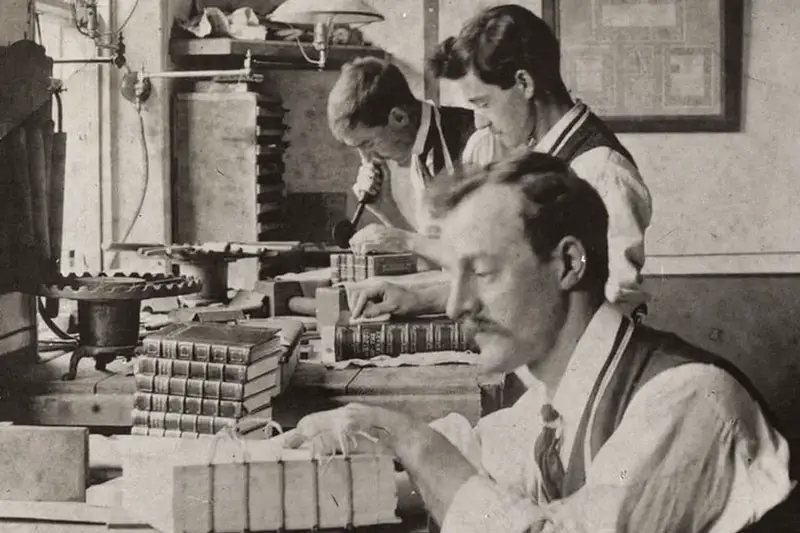
What was the Rubáiyát of Omar Khayyám?
Sangorski's fascination was centred around a collection of poetry by the 13th-century Persian mathematician and astronomer Omar Khayyám. Translated into English by Edward FitzGerald, the verses gained popularity in the late 19th century. An expedition in 1885 to Khayyám's tomb further increased interest. The book appealed to Sangorski's romanticized view of the East, which was a common sentiment at the time. He had previously bound smaller versions of the Rubáiyát, but the full quarto-sized Houghton Mifflin edition produced in Boston in 1884, with its captivating illustrations by Elihu Vedder, provided the ideal canvas for a more extravagant design.
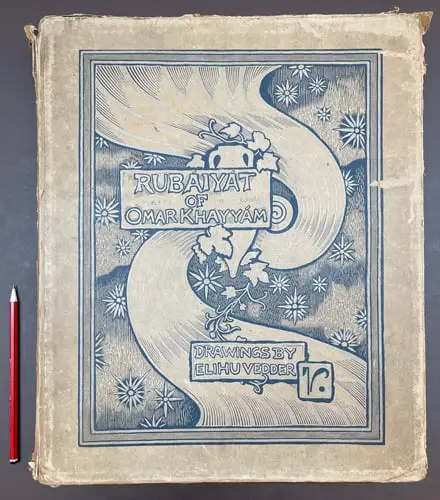
Sangorski aimed to create something exceptional, but he required a commission to justify the investment of time and effort. Fortunately, he found this opportunity through John Harrison Stonehouse, the manager at the prestigious rare bookseller, Henry Sotheran & Co. Stonehouse recognized the potential profitability of presenting the work to coincide with the coronation of King George V, and according to his 1933 memoir, he authorized Sangorski to spare no expense in creating the finest binding possible.
"the greater the price, the more I shall be pleased".
It seems that Stonehouse did not discuss this plan with his employer, Henry Cecil, the owner of Sotheran & Co., an oversight that would prove costly later on.
The 1884 Elihu Vedder Edition

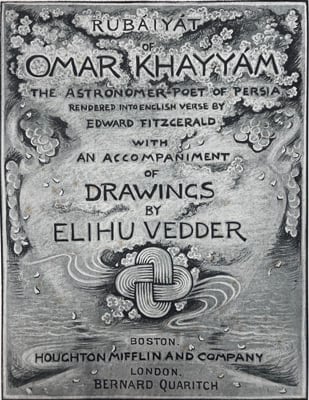

Things began to unravel when it became clear that the book would not be anywhere near ready in time for the coronation, but Stonehouse decided to exhibit it anyway in its unfinished state, as reported in The Graphic Magazine:
... in designing and executing the amazingly sumptuous cover for Omar Kbayyam's "Rubaiyat," now exhibited by H. Sotheran and Company at 43, Piccadilly. Two years' unremitting labour has been bestowed upon this truly unique example of the bookbinder's art and even now the front of the cover awaits completion. Priced at £1000-which does not seem excessive in view of the fact that no fewer than 1050 specially cut precious stones have been inserted into the design, this cover is unquestionably the most magnificent production of its kind in modern times.

After many more months of work, Sangorski and Sutcliffe finally had the book ready for sale, its features were truly astonishing:
An endeavor has been made by the binders to suggest, both in color and design, all the beauty, extravagance, and splendor of Eastern decoration. Richness has been the chief aim, and although a certain symbolism is suggested in the·various designs, there has been a recognition of the limitations of the tools and materials, and no vain striving after pictorial or theatrical effects has been attempted.
Sunk panels of ornamental shapes are introduced into both covers and doublures, to break up the monotony of a flat surface, and also to avoid excessive projection of the jewels that are inset. The 1,050 stones comprise rubies, turquoises, amethysts, topazes, olivines, garnets, and an emerald. They are introduced into the decoration and each stone is in a gold setting, which is firmly fixed underneath the leather, thus making it almost an impossibility for it to come out. Close gold tooling, producing in appearance the richness and splendor of solid chased gold panels, is strongly in evidence on the whole work, and affords a fitting background for the jewels.
On the front cover, in a sunk panel of a shape suggestive of Persian architecture, appears, as a central figure, a heart shape, richly jeweled with rubies, olivines, and garnets, and closely gold tooled. This is surrounded by a conventional arrangement of three peacocks, elaborately inlaid in their many natural lines, and filling, with the graceful radiating lines of their tails, the remainder of the panel.
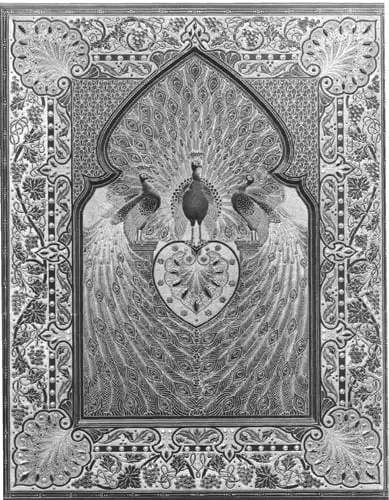
(From the original negatives, courtesy of Shepherds, Sangorski & Sutcliffe)
The eyes of the feathers are jeweled with ninety-seven topazes, all of which are speclally cut to the correct shape of the eye. The crests of the birds are suggested by eighteen turquoises, and rubies are inset to form the eyes. The slight background thus left is tightly filled with gold dots.
Surrounding this panel is a border and corner piece, suggestive both in color and design of characteristic Oriental decoration, and set with 289 garnets, turquoises, and olivines. The design is completed with a border suggesting a conventional treatment of the vine inlaid in brown and green, and set with 250 amethysts arranged so as to form the bunches of grapes.
The back cover is divided into a number of sunk panels of Persian shapes. These are closely filled with gold foliage and set with 198 turquoises, garnets, and olivines. Inlaid in the centre panel is a model, complete In every detail, of a Persian mandoline, made of mahogany, and inlaid with silver, pearl, satin wood, and ebony. A border, composed of a graceful arrangement of lines and dots, completes the design on this cover.

The front doublure is also divided into a number of sunk panels, and in the centre one is a subtle suggestion of Stanza 58 of the original verses by FitzGerald.
Oh Thou, who man or baser earth didst make,
And who with Eden didst devise the snake,
For all the sin wherewith the face of man
Is blackened-man's forgiveness give and take!The second line was afterward changed to read:
And ev'n with Paradise devise the snake,
This stanza is not a translation of Omar's text, but an interpolation by FitzGerald.
The dominating feature therefore of the panel in question is a snake, modeled and inlaid in various colored leathers, with ivory teeth and an emerald set in as the eye. The snake is surrounded by and entwined among a conventional arrangement of an apple tree, with the sun, suggested in solid gold, appearing through the foliage. The whole of the background is closely filled with gold dots, throwing the design slightly into relief. The panel is also intended to be an emblematical suggestion of life in contrast to that of the back doublure, which is a suggestion of death. The corner and side panels are jeweled with forty-eight turquoises and garnets and closely filled with foliage. An elaborate border of an Oriental character completes the design.
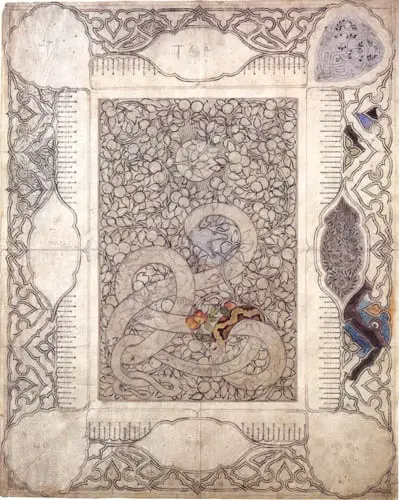
The design of the back doublure, as stated, is intended to be an emblematical suggestion of death, In a sunk panel on the doublure appears a realistic representation of a skull, modeled in leather and with carved ivory teeth. The skull is surrounded with a design based on the poppy, the floral symbol of death. An elaborate border, composed of interlaced, inlaid bands and foliage, forms a frame for the panel.
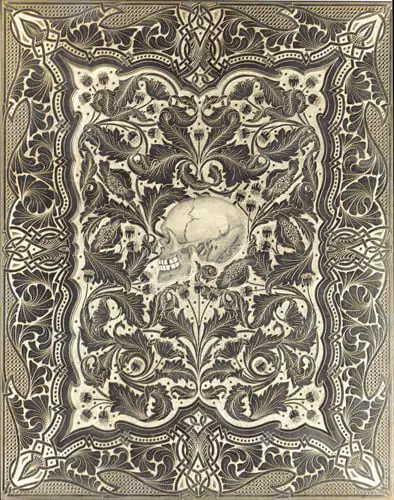
The front flyleaf is decorated with an intricate inlaid strapwork border, with an inlaid rose in the corners, the introductlon of the flower being intended to carry out further the suggestion of life at the beginning ot the book. The back flyleaf is similar in appearance to the front one, but the design in the corners instead of being based on the rose suggesting life, is composed of a conventional treatment of the deadly nightshade, but to taste which is death. — The New York Times, 7 April 1912
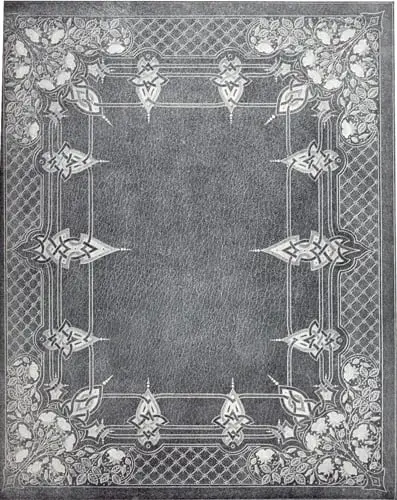
With a list price of £1,000, the only question now was, who in the world would buy it?
Searching for a buyer
Sotheran & Co. described themselves as booksellers to the King so they harboured hopes of royal patronage. Sangorski himself was sent on a speculative mission to tout the Omar to the collector of books at Windsor Castle, but he had no success, indeed the King's librarian seems to have actively disliked ornately decorated books and would later deride the edition as "the most eminent failure, perhaps, that I ever saw'.
The book was a very large quarto, an American production of Fitzgerald's Omar Khayyam in bad lettering with bad ornament in the margin, a very costly affair upon which money and pains had with the best intentions been most unfortunately misspent. ... Sangorski brought this copy to me himself with great pride, placed it tenderly in my hands and asked a thousand pounds for it. The binding was of the very best Morocco leather, with infinite elaboration of tooling, blind and gilt, of inlaying and even of enrichment by amethysts, moon stones and the like less precious stones. The whole had been most painfully designed, and had been executed with an admirable and conscientious workmanship which must have kept the craftsman busy for months together. Yet it was absolutely inappropriate, ineffective and even insignificant, and to me personally a positive distress. I did not hurt Sangorski's feelings by giving him my true opinion of it, but simply declined even to make an offer for it, and sent him away with good words. I heard from time to time that the book had been offered and rejected in this quarter and that, and at last that it had been shipped off - whether to order or on speculation I never knew — to the United States. The ship that carried it sank in mid ocean, and the ill-starred book now lies at the bottom of the Atlantic, which is the best place for it. — John Fortescue (1934)
Following this setback, Sotheran decided to cast their gaze across the Atlantic, training their sights on wealthy Americans, in particular, book dealer and occasional philosopher Gabriel Weis.
Weis (he later changed his name to Wells) regularly travelled to London to attend sales. He offered £800 for the Omar, which was declined by Sotheran, who counter-offered with £900; Weis baulked at this sum, presumably aware in such a limited marketplace that he might struggle to sell it on at a profit.
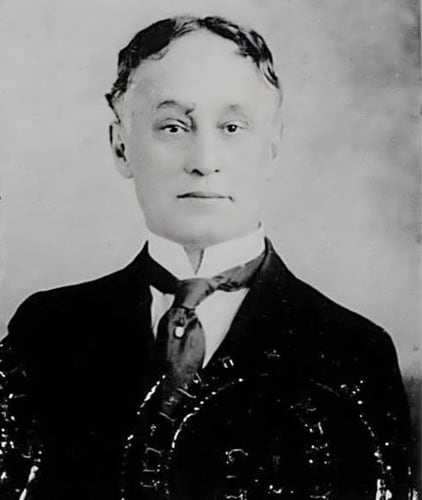
It has been speculated that Sotheran and Weis saw book collector and philanthropist Phoebe A. D. Boyle as their most likely customer. It's unclear if there is any firm evidence for this. But what is known is that Sotheran now despatched the book to the United States to be exhibited, apparently on order from an unidentified New York firm which, according to The New York Times, had a particular customer willing to part with $4,250 for it.
While Boyle did maintain an impressive library containing many editions that had emerged from the bindery of Sangorski and Sutcliffe, another intriguing possibility is that the intended buyer was J. Pierpont Morgan, the man whose International Mercantile Marine conglomerate was the parent company of the White Star Line, owners of RMS Titanic. On 11 April 1912, even while Titanic bore his greatest creation westward, Sangorski addressed the Library Association and remarked that Morgan had recently returned a previous Sangorski binding of the Rubáiyát because it had been inset with Opals, which some considered to be bad luck. After the sinking, some newspapers speculated that J.P. Morgan may have been the ultimate recipient.
Unfortunately, when the book arrived at US customs sometime in January 1912 the border authorities declared they would charge duty for the import of up to 25% of its original $5,000 valuation. This was unexpected because at that time a book which was more than 20 years old, even with a new binding, could be imported duty-free, but the Vedder edition, although printed in 1884, had no obvious date markings. With the unknown New York firm unwilling to pay the fee, a new round of negotiations with Weis ensued, but the contretemps over customs duty had had its effect, and despite offering Weis an improved price of £750, £50 less than Weis had tendered previously, the wily New York dealer stood firm and now refused to pay any more than £600. Unable to agree terms with Weis, Sotheran had the book returned to England.
Henry Cecil of Sotheran & Co. seems now to have wanted the book off his hands once and for all. A financial dispute with Sangorski seems to have been the final straw, and he peremptorily, and foolishly in the event, had the book consigned to auction at Sotheby's, without reserve. The auction took place on 29 March 1912, and Weis, back in New York for the huge Robert Hoe library sale, instructed his London agent, local bookseller Abraham Lionel Isaacs, to bid up to "$3,125, but with instructions to go higher, if necessary," and was astonished to discover that the bidding halted at £405 (around $2000). Newspapers hinted at a certain disdain among collectors toward modern bindings being the reason for the relatively low price being realised. But whatever the reason The Great Omar was finally sold.
The book was parcelled up in an oak casket and Weis made arrangements to have it shipped back to New York.
The interesting question now arises, what duty will Mr. Weis have to pay to obtain the book, or will he have to pay any? He maintains that he ought to receive it free of duty because it was issued in 1884, and also because it is an American printed book. ... Mr. Weis has not yet given an order to have the "Omar" shipped to him here, but it is quite probable that it will be in New York within two or three weeks. — The New York Times, 7 April 1912
Was the Rubáiyát ever actually on the Titanic at all?
It has been stated that Weis intended for the book to be shipped out on 6 April 1912, and that somehow this crossing on an unidentified ship was missed, perhaps due to the ongoing coal strike which caused numerous crossings to be cancelled or rescheduled, so far no source for the exact date of 6 April has been found, but the New York Times (21 April) mentioned the book having missed a previous crossing.
There is also no documentary proof that the book was actually on board the Titanic for the crossing that departed from Southampton on 10 April, it is not specifically included on the extant copy of the Titanic's cargo manifest that was reprinted in The New York Times on 21 April 1912, but the possibility remains that Weis asked a trusted friend to convey it personally to New York. Given the book's fame and the previous well-publicised controversy at US customs, it seems highly unlikely that Weis would have done so in a brazen effort to avoid import duty, which given the markdown in price, were he not able to avoid it entirely, would have been much less than before.
It is often speculated that the courier was First Class Passenger Harry Elkins Widener. Harry Widener and Gabriel Weis would certainly have known of each other, both being a part of that highly select group of wealthy bibliophiles that haunted book sales and auctions on both sides of the Atlantic. But they were also competitors and it is unknown if they were friends.
But if the book was not on the Titanic it is hard to explain the ongoing mystery of its whereabouts.
At the ongoing "Hoe" library sale on 16 April 1912, Gabriel Weis himself confirmed that the book had gone down with the Titanic; his statement was quoted in the New-York Tribune the following day and mentioned that he had received a cable from his agent in London, Mr Isaacs, to say that the book had been insured for £500.
Where is the Rubáiyát now, and could it be recovered?
If the book was shipped in Widener's luggage, it may have been placed in his cabin; the Wideners occupied C-80-82 on the port side of C-Deck., with Harry, usually reported as having occupied C-82. However, the book, even the unadorned versions we can consult today, was large, heavy, and contained in an oak casket.

(Titanic Plans courtesy of Matt De Winkleer)
Notwithstanding the fanciful scene in Titanic '97 where Rose studies impressionist and abstract masterpieces scattered casually around her stateroom, it seems far more likely that a passenger transporting a selection of large and valuable items would have them consigned to a safe, or strongroom. This would offer the best hope that the book, in its protective oak case, could have survived the sinking intact, though in what location remains a mystery. Given that the Widener's cabins were in an area largely destroyed when the Titanic split in two, if by chance it was left in the Widener's cabin it is a remote but tantalizing possibility that the book miraculously survived the breakup and lies somewhere in the debris field waiting to be found.
A legend attached to the Titanic story is that Harry Widener did retrieve one book from his cabin: a newly acquired copy of Bacon's Essays, which he put in his pocket telling his mother as he helped her to a lifeboat: "I have placed the volume in my pocket, the little Bacon goes with me!" He then stepped back and lost his life in the disaster. The truth is unknown, the story has never been corroborated by anyone actually aboard the Titanic; it probably stems from the recollection of bookseller Bernard Alfred Quaritch who met Widener in London:
When young Widener came to say good-bye he laughingly took from his pocket the small Huth Bacon's Essays1, which he had carried since the sale, and said to Mr. Quaritch: “If I am shipwrecked you will know that this will be on me.” — The New York Times, 9 June 1912
A Selsey Drowning Tragedy
Selsey Bill is a headland on the south coast of England, a popular holiday destination within easy reach of London.
A few weeks after the sinking of the Titanic, Francis Sangorski travelled to Selsey for a seaside holiday with his family and some friends. He was probably shattered by the drama surrounding the sale and subsequent loss of a work that had taken up more than two years of his life.
On the morning of 1 July 1912, the last day of their break, he decided to go bathing in the sea. At a location near the Marine Hotel, he got into difficulties, perhaps caught out by a strong current, and was swept out to sea. His friend and neighbour Donald Warner2, and a young woman, Elizabeth Dorothea Thorburn3 were also taken by the current. Warner managed to assist Miss Thorburn to shore but Sangorski drowned, his body being recovered about an hour and a half later.
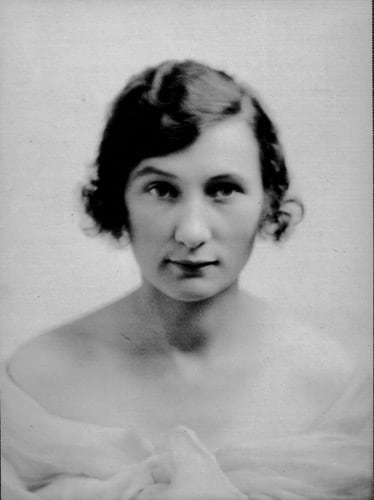

The death of Sangorski could have been the end of the Great Omar saga, but, mindful of the publicity attending its loss on the Titanic, he and his partner George Sutcliffe, had told reporters that they had saved all the designs for the Great Omar, and preserved photographic negatives of the covers so they could produce a replica should someone wish to commission one.
“Art Treasure Lost.”
The designers and binders of the “Rubaiyat" of Omar Khayyam, lost on the Titanic (Messrs. F. Sangorski and G. Sutcliffe), state that all the designs were copyrighted by them, and are still in their possession. They add that instead of working to no definite plan the work was executed from working designs, every detail of which is recorded. The composition of these designs entailed some six or eight months' work, and the execution two years, and it is quite possible for them to reproduce the whole work. — Sheffield Evening Telegraph - 23 April 1912
In the end, two replicas were produced from these archives. Both were made by Stanley Bray, a nephew of Sutcliffe. The first was produced in the 1930s but was destroyed during the Blitz. Bray kept the remains and salvaged the jewels for the third 'Omar', completed in 1989 and presented to the British Library, at the same time a colourized version of the original negative was produced.
Unless the book that was lost on the Titanic is found, this may be the closest we will ever come to visualising and appreciating the craftsmanship that Francis Sangoski and George Sutcliffe brought to the legendary Rubáiyát of Omar Khayyám.
Notes
- Widener's copy of Bacon's Essaies was a rare second edition dating from 1598 which Quaritch had bought at the 1911 Huth library sale at Sotheby's for £200, either on behalf of Widener or subsequently sold it to him. The book measures just 13cm x 8cm x 1cm, so would easily fit in a pocket.
- Donald Warner (1877-1944).
- Elizabeth Dorothea Thorburn (1894-1991).
Sources
Newspaper and Magazine Articles
The Illustrated London News, 24 January 1885, Tomb of Omar Khayyam, The Persian Poet, At Nishapore
The Daily Telegraph, 20 June 1911, £1,000 Omar Khayyam
The Bookseller, 23 June 1911, Messrs. H. Sotheran & Co.
The Graphic, 29 July 1911, Omar Khayyám Enshrined: A Masterpiece of Modern Craftsmanship
The Daily Telegraph, 30 March 1912, Gretna Green Relics: Quaritch's "Twopenny Box" Again
The New York Times, 7 April 1912, This Gem-Studded Book is the Top Notch of the Binder's Art
Sheffield Evening Telegraph, 12 April 1912, Artistic Bookbinding
New-York Tribune, 17 Apr 1912, Jeweled Book Lost, Fine Copy of "Rubaiyat" Went Down in the Titanic.
The New York Times, 21 April 1912, Cargo of Titanic Valued at $420,000
The New York Times, 21 April 1912, Precious Book Lost When Titanic Sank: Jeweled Specimen Of Modern Craftsmanship, Costing $2,000, Missed a Previous Boat
Sioux City Journal, 21 April 1912, Book Studded with Jewels
The Observer, 21 April 1912, Tragedy Of A Book: Beautiful "Omar" Lost With The Titanic
The Daily Telegraph, 23 April 1912, [Letter from Sangorski & Sutcliffe]
The New York Times, 9 June 1912, Rare Book Lost with H. E. Widener
Chichester Observer, 1 July 1912, Russian Visitor Drowned
Portsmouth Evening News, 3 July 1912, Selsey Bathing Fatality
The Daily Telegraph, 3 July 1912, Death of Mr. F. Sangorski
West Sussex Gazette, 4 July 1912, A Visitor Drowned, Dangers of the Tide
Evesham Standard & West Midland Observer, 6 July 1912
The Daily Telegraph, 6 August 1912, Literary Dispersals
Pall Mall Gazette, 30 December 1912, Last Work of a Famous Binder
The Saturday Review of Literature, 30 March 1929, [Bust of Gabriel Wells]
The Illustrated London News, 16 August 1930, For the Persian Art Exhibition? the New Omar M.S. of 1505
The Age (Melbourne, Victoria, Australia), 11 Nov 1944, The Great Omar: Jewelled First Edition
The New York Times, 7 November 1946, Gabriel Wells, 85, Book Dealer, Dies
The Daily Telegraph, 5 January 1996, Stanly Bray [Obituary]
The Daily Telegraph, 2 May 1999, The Lost Great Omar
Printweek, 27 March 2009, A Model, Modern Artisan [Profile of Rob Shepherd]
Online Resouces
British Library, 16 May 2023, The 'Titanic Omar' Preserved for all Time (Virtually)?
British Library, Great Omar Jewelled Bookbinding Digital Recreation, C.188.c.27, License: CC Attribution (CC BY © British Library Board)
Peter Harrington, 12 April 2022, The Cursed Book: Sangorski And Sutcliffe’s ‘Great Omar’
BBC News (London), 15 April 2022, The Book that Sank on the Titanic and Burned in the Blitz
Sangorski & Sutcliffe History
Books
Omar Khayyam, Edward FitzGerald (1809-1883), Elihu Vedder (1836-1923) (1884) Rubáiyát of Omar Khayyám, the astronomer-poet of Persia, Boston: Houghton Mifflin; London: Bernard Quaritch
John Harrison Stonehouse (1933) The Story of the Great Omar Bound by Francis Longinus Sangorski, Piccadilly Fountain Press
John Harrison Stonehouse (1933) The Story of the Great Omar and the Loss of the Titanic, Piccadilly Notes #3, Henry Sotheran Ltd
John Fortescue (1934) Author and Curator, Blackwood and Sons
Stanley Bray (1989) The Final Story of the Titanic Omar, The Penmiel Press, Esher, Surrey
Rob Shepherd (2015) The Cinderella of the Arts: A Short History of Sangorski & Sutcliffe, Oak Knoll Press
Rob Shepherd (2001) Lost on the Titanic : The Story of the Great Omar, London: Shepherds, Sangorski & Sutcliffe, and Zaehnsdorf
Acknowledgements
The family of Elizabeth Dorothea Patton (née Thorburn).
Alison Strachan, managing director of Shepherds, Sangorski & Sutcliffe, 76 Rochester Row, London, SW1P 1JU for supplying original images of the great Omar, as can be seen by the example below, the firm continues to create beautiful bindings from their workshop, visit www.bookbinding.co.uk for more information about the bindery.
Thanks also to the rare books department at Bodleian Library, Oxford for information regarding Bacon's Essaies and the Vedder edition of the Rubaiyat.
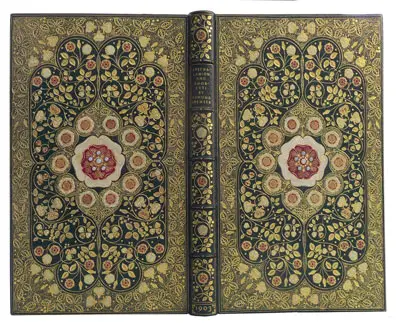
Comment and discuss